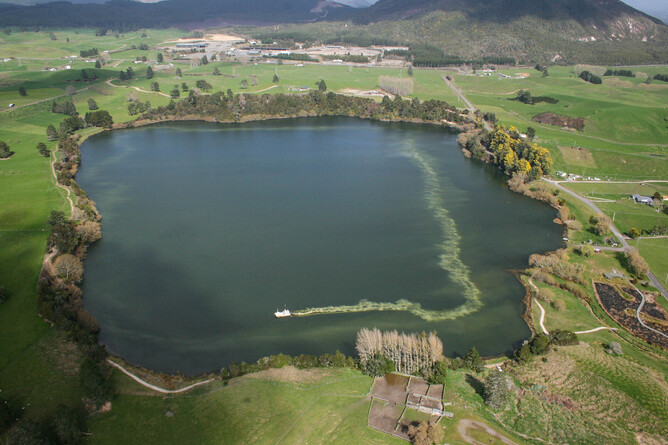InsideResources, Bernie Napp Aug 2018
A zeolite product designed to clean up phosphate in the Rotorua lakes has found a market in the United States. “In the last few months, there has been a lot of interest overseas,” says Andy Campbell, sales director at Blue Pacific Minerals. Co-designed with Scion, Aqual-P was developed on the back of government funding grants in the early 2000s and then shelved until recently. Campbell ascribes the present upsurge to increased environmental consciousness and concern in the US over nutrient pollution in lakes. Target customers include subdivision and golf course owners, anxious to avoid toxic algal blooms in their waterways, and to treat them with environmentally-friendly methods. “This is where Aqual-P comes into its own. We are starting to sell some product into the US. We are looking at alternative manufacturing opportunities, and at different products.”
THE U.S. OPPORTUNITY
Blue Pacific Minerals is in contact with a US company employing more than 200 staff in 25 States, a large player in the US lake management market. It is a subsidiary of a company listed on the Financial Times Stock Exchange 100 index. “It’s early days with this company,” Campbell says. “They have done early trials; and are wanting to develop a long-term relationship.” Trial shipments to date have amounted to about 4 tonnes. Depending on lake conditions, a one-hectare lake may need 1.5 tonnes of Aqual-P to remove the phosphate, or dosing of 150 grams per square metre of water column. The aim is to export 100 tonnes of product in the first year of supply, and target revenue of around a million dollars.
HOW AQUAL-P WORKS
Particles of zeolite have a filament attached, via a chemical reaction involving an aluminium polymer that removes the dissolved phosphate from solution. This is the active product. Blue Pacific Minerals perlite and traded minerals sales manager Bernard Novak says the company is exploring spin-off products from Aqual-P. For now, the modified zeolite is bonded irreversibly with dissolved phosphate. By introducing different chemistry, a reversible bond could be formed that would allow the zeolite that captures phosphate to be collected, and redeployed as fertiliser on farms. “That is the long-term possibility,” Novak says.
INTERNATIONAL COMPETITION
Campbell says a different product with the same aim has been developed in Australia. Despite its expense, it is beginning to create interest in international markets.This product has found good favour in the market but does have its issues. Aqual-P has been shown to be free of any significant side effects. Benefiting from Chinese investment, this product is now accredited for use in China. For an idea of the scale of the opportunity, the company, trading under the brand of Phoslock, has increased its market capitalisation from AUD $15 million to AUD $200 million within the last year.
ROTORUA LAKES RESEARCH
Blue Pacific Minerals’ and Scion’s initial development and trials were carried out at Lake Okaro in the Bay of Plenty, and a product with worldwide marketing rights created. The Government was to implement the programme, and then took a broader view to include phosphate inputs into the lakes from the entire catchment, and included a focus on land use practices, Campbell explains. At that time phosphate levels in waterways appear to have stabilised and are potentially in decline. An alternative phosphate reduction agent was deployed, alum (aluminium sulphate), with a potential risk of aluminium toxicity in water under certain conditions. Campbell says the advantage of Aqual-P is its effectiveness, and no environmental downside.
